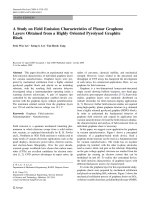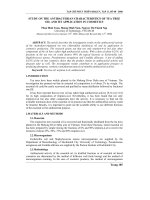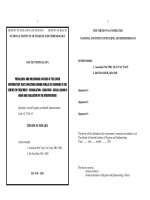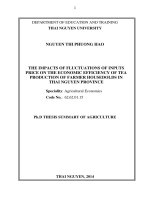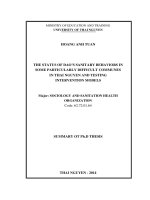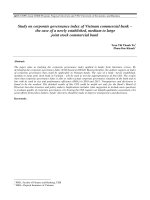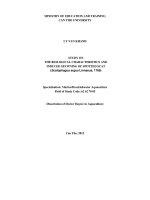STUDY ON SOME EPIDEMIOLOGICAL CHARACTERISTICS OF LOWER REPRODUCTIVE TRACT INFECTION OF MOUNTAINOUS WOMEN IN THAI NGUYEN PROVINCE AND EFFECT OF INTERVENTION
Bạn đang xem bản rút gọn của tài liệu. Xem và tải ngay bản đầy đủ của tài liệu tại đây (5.02 MB, 27 trang )
MINISTRY OF EDUCATION AND TRAINING
THAI NGUYEN UNIVERSITY
---------------------------------
NONG THI THU TRANG
STUDY ON SOME EPIDEMIOLOGICAL
CHARACTERISTICS OF LOWER REPRODUCTIVE
TRACT INFECTION OF MOUNTAINOUS WOMEN IN
THAI NGUYEN PROVINCE AND EFFECT OF
INTERVENTION
Speciality: Social Hygiene and Health Administration
Code: 62 72 01 64
THESIS SUMMARY
THAI NGUYEN – 2015
THE THESIS WAS COMPLETED
COLLEGE OF MEDICINE AND PHARMACY
THAI NGUYEN UNIVERSITY
Scientific supervisors:
1. Assoc. Prof. DAM KHAI HOAN, PhD
2. Assoc. Prof. NGUYEN DUC HINH, PhD
Opponent 1: . ...........................................................
Opponent 2: ............................................................
Opponent 3: . ...........................................................
The thesis will be defended at the
Dissertation committee in National level
COLLEGE OF MEDICINE AND PHARMACY - TNU
Time ......date.....month ......year 2015
The thesis stored at:
National Library
Learning Resource Center - Thai Nguyen University
Library of College of Medicine and Pharmacy - TNU
1
INTRODUCTION
Reproductive tract infections (RTIs) is one of the most
common disease of reproductive age women. This disease imposes
negative impacts on reproductive health, working and quality of life
of women. According to the World Health Organization (WHO),
there are about 50% of reproductive age women have RTIs, mainly
focus in developing countries. In Vietnam, the rate of RTI is
relatively high, ranging from 40-80%, depend on research. Notably,
this rate increased in rural areas as in Ha Nam low-lying rural
(58.39%); Hai Duong delta rural (52.0%). In our country, RTIs
prevention program has been implemented many years ago but the
efficiency of the program is not high, especially in mountainous and
remote areas. Rural women are at high risk of RTIs due to adverse
factors about hygiene conditions, working conditions and living
standards, ability for health services approach and knowledge,
attitude and practices on RTIs prevention.
Thai Nguyen is mountainous and midland province, living
standard of people is at moderate level; the reproductive health care
still faces many difficulties. Thus, the rate of RTIs in women may
high. Effective RTIs prevention solutions for rural women should be
required. The question is: What is current situation of RTIs in
mountainous reproductive age women? What are the risk factors of
RTIs morbidity in reproductive women? What are the effective
prevention solutions of RTIs in Thai Nguyen rural mountainous
women? Based on these questions, we implement this project with
the following objectives:
1. To describe some epidemiological characteristics of lower
RTIs of mountainous married women at reproductive age in Thai
Nguyen in 2012.
2
2. To determine factors of lower RTIs of mountainous married
women at reproductive age in Thai Nguyen.
3. To evaluate the effect of RTIs prevention solutions for
mountainous women in Thanh Cong commune, Pho Yen district, Thai
Nguyen province after 2 years of intervention.
NEW CONTRIBUTIONS OF THE THESIS
1) Is a comprehensive study of RTIs for rural mountains
women. Results showed that prevalence of RTIs was 35.4%; high
RTIs prevalence focused on women aged 25-34; ethnic Tay, Kinh,
Nung, Kinh; farmer women; poor women and women in low land
areas of Thai Nguyen.
2) Has been identified 12 risk factors of RTIs in rural
mountainous women in Thai Nguyen: Practice of RTIs prevention is
not good; Unhygienic water; Knowledge of RTIs prevention is not
good; do not have regular gynecological examination; Poor women;
Do not get prevention counseling; Attitude of RTIs prevention is not
good; Unhygienic bathroom; Farmer women; Kinh ethnic women;
low education level women; women with more than two children.
3) The community - based model on RTIs prevention for
rural mountainous women in Thanh Cong commune, Pho Yen
district, Thai Nguyen province is accessible, practical and acceptable.
The efficiency of models after 2 years of intervention: In intervention
commune: the rate of good knowledge increased 66.0%, good
attitude increased 28.0%, and good practice increased 43.0% (p <
0.05). The rate of women used hygienic bathroom and hygienic water
in intervention commune increased 22.5% and 24.0%, respectively (p
<0.05). After intervention, the satisfaction rate and and get
counseling rate increased 22.5% and 43.0%; respectively, (p <0.05).
Prevalence of RTIs in intervention commune decreased to 12.5%,
compare with 35.5% before intervention (p<0,05). While in control
commune, the changing is not significant.
3
STRUCTURE OF THESIS
The thesis is 114 pages, including: Introduction 02 pages;
Chapter 1. Literature review: 26 pages; Chapter 2. Subjects and
methods: 26 pages; Chapter 3. Study results: 35 pages; Chapter 4.
Discussion: 22 pages; Conclusions: 02 pages, Recommendations: 01
pages.
The thesis results are presented in 25 tables, 12 images and 05
boxes. Thesis has 120 references, including 70 Vietnamese
references and 50 English references.
KEY PARTS OF THESIS
Chapter 1. LITERATURE REVIEW
1.2. Epidemiological characteristics of RTIs in women
1.2.1. RTIs in reproductive age women worldwide. RTI is one of the
most common disease in reproductive age women worldwide.
According to WHO, there are about 50% of reproductive age women
have RTIs, mainly focus in developing countries. The highest
prevalence of RTIs are in the Africa countries, South Asia countries;
this prevalence is lowest in European countries and North America.
1.2.2. RTIs in reproductive age women in Vietnam. Overall, the
study in Vietnam report the rates of RTIs ranging from 40% to 80%
depend on study setting, this is a demonstration for the necessary of
more positive impact to reduce RTIs prevalence. Besides that,
specific researches on RTIs for rural mountainous women still rarely
mention.
1.3. Risk factors of reproductive tract infections in women
1.3.1. Health behavior of women. Previous study by Zhang X. J. et
al (2009) showed that hygienic genitals behavior before having sex
with husband is associated with RTIs (OR = 1.021; 95% CI: 1.005 to
1.037), the same with other studies... Some studies in Vietnam also
reported that the main risk factors of RTIs are culture, hygienic
4
genital habit, women hygiene is not scientific, lack of RTIs
knowledge: Lam Duc Tam (2011), Can Thi Hai Ha (2014)...
1.3.2. Environmental and social factors. The hygienic conditions
such as clean water, bathrooms, are related to RTIs. Study of Zhang
X. J. et al (2009), Jespers et al (2014) showed these risk factors. In
Vietnam, study of Nguyen Trong Bai and Vo Van Thang (2009), Do
Mai Hoa (2009), Pham Thu Xanh (2014) all reported that using
unhygienic water or unhygienic, private bathroom are increased the
risk of RTIs.
1.3.3. Health care system factors. Study in 07 different ecological
regions of country showed that RTIs counseling is conducted on
14/24 health care facilities but only 10/14 health care facilities have
ability for RTIs diagnosis and treatment. Family planning/
reproductive health (RH) care services is organized as the campaign,
instead of regularly held at CHS which organized the campaign;
which is affected to health care services approach of women in the
community.
1.3.4. Demographic and other factors. Including demographic
factors such as age, occupation, education level...; and obstetric
factors such as number of delivery, or a history of abortion, history of
RTIs... are closely associated to RTIs...
1.4. Reproductive tract infections prevention models
1.4.1. Some reproductive tract infections models in the world
1) Study of Aggarwal A. K et al (2004), conducted by health
education in the community about RTIs and HIV/AIDS prevention,
have significantly improved knowledge and health care services
approach after intervention.
2) Study of Esere M. O (2008) by reproductive health
education in schools has significantly improved knowledge, attitudes
about and improved health risk behaviors in the intervention group.
5
1.4.3. Community - based model for health education in Vietnam
1) Mobilizing village teachers in the community participate
in reproductive health care models by Dam Khai Hoan et al (2003)
was conducted by reproductive health communication for
communities through students and their parents. The changing results
after intervention is remarkable on reproductive health indicators.
2) Sexual transmitted infections prevention model for
workers in some factories. After 01 years of intervention, the result
shows a remarkable change in knowledge, attitudes and practices of
RTIs prevention.
Chapter 2. SUBJECTS AND METHODS
2.1. Subjects, setting and duration of study
2.1.1. Study subjects: Rural mountainous and married women in
reproductive age (15-49 years old); Staffs of district preventive
medicine centers, staffs of CHSs, village health workers, population
collaborators; Leaders of governments, agencies and organizations in
villages and communes and.
2.1.2. Study settings: Rural areas of 03 mountainous districts: Dong
Hy (Van Lang and Linh Son commune), Pho Yen (Thanh Cong intervention and Phuc Thuan - control commune) and Vo Nhai (Lau
Thuong and Phu Thuong commune) in Thai Nguyen province.
2.1.3. Study duration: from January 2012 to December 30th 2014.
2.2. Methodology
2.2.1. Study design: Designed as Explanation sequential design
model. The quantitative study design includes 03 epidemiologic
studies: Cross-sectional study, case control study and community
intervention with controll group.
6
2.2.2. Sample, and study sampling for quantitative study
2.2.2.1. Sampling for cross-sectional study. Estimating a population
proportion with specific absolute precision formula, where p = 0.465
(RTIs prevalence in An Lao, Hai Phong), d = 0.04, calculate, rounded
up n = 1200 (400 for each district).
* Laboratory sample. Select the RTIs subjects by clinical
examination screening for gynecological exams, Pap tests and dye
discharge, vaginal pH test, Chlamydia test.
2.2.2.2. Sampling for case control study. Use case control sample
formula with the rate of married women 18-49 years old in the island
areas, who does not have the bathroom in RTIs group accounted for
48.47% (p1 = 0.4847) and p0 = 0.40 in previous study. Substituting,
rounded up n = 400. Select case/control group according to ratio 1: 1,
400 women for each group. This is match case control study with the
match are age and village.
2.2.2.3. Sampling for intervention study
* Sample size: Use community intervention sample formula with p1
is good RTIs prevention practices according to the results of previous
study: 30%. p2: the rate desire to achieve, is expected to be 70%.
Substituting these number, rounded up n = 200.
* Sampling method: simple random sampling method.
2.2.3. Qualitative sampling method
- In-depth interview subject: The director of district health center;
secretary of reproductive health care program in CHS and in district
health center.
- Group discussion: (i) Group discussion with leaders of the Labor
party committee, People's Committee, head of departments and heads
CHS in three communes of 3 districts (3 group discussions); (ii) 3
group discussions with representatives of village leaders, village
health workers and population cooperation staffs; (iii) 3 group
discussions with representatives of the RTIs women.
7
2.3. Community intervention
2.3.2. Community - based model intervention
Model title: Mobilizing community - based model on RTIs
prevention for rural women in Thanh Cong commune, Pho Yen
district, Thai Nguyen province
Model developing process
1) Developing model resources: Establish the board of
administrator and its tasks; training for board/committee’s members;
Building facilities.
2) Implementing community intervention activities: CHS
strengthen the patient management, treatment and monitoring the
communication activities in the commune. Coordination with
community sectors and organizations to do health education
communication about RTIs and environment sanitation.
3) Post- intervention evaluation: Evaluate the education
intervention indicators, management indicators and effectiveness of
model.
2.4. Study indicators
2.4.1. Classify study variables
* Variables related to RTIs epidemiology: Prevalence of RTIs
women; RTIs among age groups...
* Variables related to risk of RTIs: Age, education level,
ethnic, average income...
* Variables related to community intervention
- Inpute indicators: Training workshop resuts, Number of facilities
and equipment were used, Budget...
- The activity indicators: Number of organizations and participants
participate in the model; number of sessions, the content of
communication; number RTIs patients management at CHS...
- Output: Knowledge, attitude and practice, level of satisfaction in
healthcare service, counseling at CHS. Water, bathroom. Number of
RTIs women.
8
2.5. Data collection
2.5.1. Quantitative data. Face to face interview woman aged from 18
to 49 at household, integrate with direct observation living
conditions, housing, and other sanitation such as water wells,
bathrooms of households. At CHS: implement clinical examination
for RTIs disease screening and laboratory test (pap tests, dye the
discharge, check pH vaginal, Chlamydia test) for women.
2.5.2. Qualitative data. In-depth inteview, group discussion with
individuals and related groups.
2.6. Data alnalysis. Data entry by Epidata 3.1 program; data analysis
by SPSS 19.0 program follow medical biostatistics. Evaluate the
intervention results based on efficiency index (EI) and intervention
effect (IE).
2.7. Ethical approval. This is a field trials study; this study does not
affect human health and environment, it has received the acceptance
of the community. This study has also been approved by the Science
council of Thai Nguyen University of Medicine and Pharmacy.
Chapter 3. STUDY RESULTS
3.1. Epidemiological of reproductive tract infections women at
rural mountainous area Thai Nguyen
3.1.1. RTIs prevalence. The pravelence of RTIs women at study
setting is relatively high (35.5%). The first leading cause of this
disease are complex bacteria infaction (43.3%); followed by Candida
infection 28.0% and lowest was Trichomoniasis (11.5%.)
3.1.2. RTIs distribution
- By age groups: RTIs prevalence of the age group 25-34 was highest
(43.6%); 35-49 years old (33.2%) and lowest at age ≤ 24 (20.8%).
- By education level: Prevalence of RTIs in women with
primary school education level or lower was highest (43.2%),
followed by women at secondary school education level (32.2%) and
lowest in women with high school education level or higher (16.2%).
- By ethnic groups: Prevalence of RTIs women among Nung
ethnic was 40.2%, followed by Kinh with 39.2%; Dao women or
other ethnic minorities groups were 17.7%.
9
- By occupation, economic conditions: Farmers women have
RTIs disease at 41.1%; higher than women in other occupations
(25.0%); poor women have RTIs at 61.8%, higher than sufficient
economic women (31.5%).
- By family size and living area: women with more than 2
children have RTIs prevalence at 65.6%, higher than women have 2
children or less (25.4%). The prevalence of RTIs in mindland
mountainous region was highest (50.3%) and lowest in the high
mountainous region was (21.8%).
Qualitative results: By group discussion and in-depth
interviews with 99 participants (in all 3 districts), we obtained the
main information as follows:
- RTIs disease is common in rural mountainous women in Thai
Nguyen 93/99 comment (box 3.1).
- Although this disease is not high mortality rate but affect to
the health and married life 81/99 comment, some typically comments
is shown in box 3.1.
- RTIs appear long time ago but have slow decreasing trend;
74/99 comment, typically, have some comments in box 3.1
Box 3.1. Real situation of RTIs now a day
“…Many women has this disease in my area; most of them don’t
take examination and treatment. I wonder why to much women got
this disease? In genneral, women who have this disease alway are
shy and afraid of talk to others...”
Nguyen Thi T, Phuc Thuan Community, Pho Yen district
“...It’s difficult to die immediately if got RTIs but this is annoying
disease, affects to women's health, affects to sex activity; to sex
partners. Uncomfotable in sex activity lead to unhappines …".
Secretary of RTIs program, Pho Yen district health center
3.2. Factors related to RTIs
3.2.1. Factors affect the RTIs disease
10
Image 3.3. Figure for classification level of knowledge in
reproductive tract infections prevention
19,5
High
Medium
58,6
Low
21,8
RTIs knowledge of women is not good: knowledge at good
level was low (19.5%), low level was high (58.6%).
Image 3.4. Figure for classification level of attitudes about
reproductive tract infections prevention
80
Good
20
No good
Good RTIs prevention attitude was relatively high (60.5%)
and not good attitude was 39.5%.
39,5
60,5
Good
No Good
Image 3.5. Figure for classification of practice level on
reproductive tract infections prevention
11
The rate of women with good RTIs prevention practices level
was 20% and not good prevention practice was 80.0%.
Table 3.10. The rate of women get counseling and sastisfaction
with the quality of RTIs healthcare services at CHS
Services
n
%
Number of women ever had gynecological examination
at CHS
710
59.2
Number of women satisfy with RTIs healthcare sevices
at CHS
511
72.0
Number of women get prevention counseling when do
gynecological examination at CHS
370
52.1
Good (satisfied & and get
counseling )
395
55.6
No Good (remaing number)
315
44.4
Service quality
(n=710)
The rate of women who ever go to CHS gynecological
examination was 59.2% with the rate of not satisfaction was high
(72.0%). The rate of women get RTIs counseling at CHS was 52.1%
with 55.6% of total satisfied with quality of sevices.
3.2. Some risk factors of reproductive tract infections
- Women have primary education level or less had higher
risk of RTIs than women have secondary education level and above
with the odds ratio OR = 1.6 (95% CI: 1.2 - 2,1).
- Kinh women had high risk of RTIs than minorities with
odds ratio OR = 1.7 (95% CI: 1.3 to 2.3).
- Farmer women had 2.2 times (95% CI: 1.6 to 3.0) times the
odds of developing RTIs rather than other occupation women.
12
- Women in poor household had 4.6 times the odds of
developing RTIs related to sufficient economy household with 95%
CI: 2.8 to 7.5.
- Mothers have many children had higher risk of RTIs than
mothers have 2 children or less with odds ratio OR = 1.5 (95% CI:
1.1 to 2.1)
- Women have not good knowledge had 6.2 times higher risk
of RTIs than women have good knowledge (95% CI: 4.1 to 9.3).
- Women have not good attitude had higher risk than women
have good attitude 3.2 times (95% CI: 2.4 to 4.4).
- Women have not good practice had higher risk than women
have good practice 10.5 times (95% CI: 6.7 to 16.5).
- Women get consulting had 3.3 times higher risk of RTIs
than women who get counseling (95% CI: 2.4 to 4.5).
- Women using unhygienic water had 6.3 times higher risk of
RTIs than women used hygienic water (95% CI: 4.4 to 9.0).
- Women use unhygienic bathroom had 2.5 times higher risk
than women use hygienic bathrooms (95% CI: 1.9 to 3.4).
- Women have regular gynecological examinations had 5.2
times high risk of RTIs than women do not have regular
gynecological examinations (95% CI: 3.7 to 7.4).
Qualitative results about risk factors of RTIs.
By group discussions and in-depth interview about the risk factors of
RTIs, we obtained the following comments:
- The leading risk factor of RTIs in Thai Nguyen rural
mountainous women is prevention behaviors was not good (79/91
comments), typically some comments in box 3.2.
- The following risk factors of RTIs in Thai Nguyen rural
mountainous women is disease prevention at the local level was not
good (70/99 comments), typically have some comments in box 3.3.
13
- RTIs risk factors in Thai Nguyen rural mountainous women
is living environment of local women was not good (65/99
comments), typically some comments in box 3.4.
Box 3.2. Reproductive tract infection prevention behaviors of
women is not good
"... I think I got RTIs because my prevention behaviors are not
good; lack of knowledge; attitude and practice of RTIs prevention
lead to higher risk of RTIs in women... "
(Mrs. Tran Thi H., Pho Yen district)
Box 3.3. Reproductive tract infection prevention program at local
level
"... In my opinion, CHS staffs and village health workers is not
fully promote their role in disease detecting, prevention
counseling in the RTIs prevention program, gynecological
examination for RTI patients was not effective…".
Secretary RH program, Dong Hy district health centers
3.3. Intervention results
3.3.1. Developing the intervention plan
3.3.1.1. Developing the community - based model for reproductive
tract infection prevention
*Step 1. Analyze the issues: Cross-sectional study results: The
prevalence of RTIs patients in rural women in Thai Nguyen province
was 35.4%. RTIs knowledge, attitudes, practice prevention of rural
women in Thai Nguyen was not good.
*Step 2: Causing analysis of priority issue and gather
information for community intervention planning: results of attitude
exploration at table 3.15:
14
Table 3.15. Women attitude with some proposed solutions to
prevent reproductive tract infections
Percentage (%)
Attitude
1
2
3
4
Health
workers
or
women
organizations invited women to
participate in RTIs prevention
activities in the community
9.6
54.4 26.0
Develop RTIs prevention club for
rural women at villages to share
knowledge and help each other for
disease preventing
1.0
9.3
63.8 17.8
Invitation to participate in RTIs
prevention club in the community
0.9
8.2
70.9 15.8
5.4
Health workers or women invited to
attend
the
RTIs
prevention 19.5 64.0 13.8
communication in the community
3.8
Proposed to share RTIs prevention to
relatives and neighbors
8.1
10.1 36.4 37.1
5
Notes: 1. Strongly support 2. Support 3. No idea
4. Objection 5. Extremely objections
Using planning based community: Provide evidence,
information; then discuss, analysis with the community to select
priority issues for intervention. We obtained the following comments
through local group discussions:
- To address RTIs prevention behaviors for rural mountainous
women, enhance communication is the leading solution. (60/62
comments).
15
- To better RTIs prevention implementation: the preferred
solution is to improve the capacity of village health workers, CHS
staffs about professional skills and disease prevention health
education communication skills (58/62 comments).
- Unhygienic water and bathrooms lead to high risk of RTIs,
therefore, improve this problem is necessary.
The main solutions for cummunity intervention as follow:
1. Solution 1. Communication: Building a community - based
model for RTIs prevention communications with the core is women's
association in Thanh Cong commune; integrate with hygienic
sanitation communication.
2. Solution 2. Enhance the capacity of RTIs prevention in
Thanh Cong commune: Focus on improving the capacity of disease
treatment, management and prevention communication.
* Step 4: Identify the solutions and specific activities
1) Communication: (i) Communication based on Commune
women association - village women associations - women and
families; (ii) - Communications through village meetings; (iii)
indirect communications through loudspeakers from the commune to
the villages.
2) Enhance the capacity for health workers, women association
staffs at both commune and village levels
- Open training courses for health workers communal, social
workers women skills to detect disease clinical examination,
treatment regimens, disease management approach.
- Open training courses about health education communication
skills for CHS staffs in disease prevention, particularly counseling
skills.
- Open training courses for village health workers / population
cooperation staffs and village women association chairman about the
16
methods, skills of health education and the content of RTIs
prevention and health management at household.
- Open training courses for village health workers / population
cooperation staffs and village women association chairman about the
methods, skills of health education about hygiene sanitation.
- Open training courses for heads of mass organizations in
commune about hygiene sanitation (water, toilet, bathroom).
* Step 5: Develop check list tool for supervising / monitoring
and evaluating to measure the output of interventions
3.3.1.2. Implementation Plan intervention model
* Develop resources for model: Has established Steering
Committee and active preventive as planned.
* Training of members of pattern: According to the tasks
assigned in the model study.
Table 3.16. The capacity improving results for health staff participate
in the RTIs prevention model before and after training workshop
Before
After
n
n
Skill
%
p
2
% (test )
Health education communication skills of board of administrator
Good
5
33.3
12
80.
Moderate
10
67.7
3
20.
Low
0
<0.05
RTIs treatment management of CHS staffs and village health workers
Good
5
16.7
24
80.
Moderate
15
50.
6
20.
<0.05
17
Low
10
33.3
0
RTIs health education communication skills of CHS staffs and
village health workers
Good
10
28.6
28
80.
Moderate
8
22.9
5
14.3
Low
17
48.5
2
5.7
<0.05
RTIs health education communication skills of commune and
villages women union staffs
Good
0
Moderate
10
Low
20
19
63.3 <0.05
33.3
7
23.4
67.7
4
13.3
There is a remarkable change after training by the increase of
good skill rate, and decrease of low skill rate: Health education
communication skills of board of administrator. RTIs treatment
management of CHS staffs and village health workers. RTIs health
education communication skills of CHS staffs and village health
workers. RTIs health education communication skills of commune
and villages women union staffs.
* Facilities/equipment for model: includes 50 RTIs
prevention books for women, 50 books on hygienic sanitation, 50
books on communication skills and 1.000 leaflets relating to
communication.
* Budget: mobilize 20 million VNĐ to spend for performing
research model. Other remaining activities are cooperation activities,
no fund activities.
18
3.3.1.3. Implementation of community interventions
Stick to intervention plan. Close monitoring using checklists.
3.3.2. The effect of intervention solutions
Table 3.23. Comparison the change of knowledg, attitude, practice of
women bout RTIs prevention in two study communes
Period
KAP
%
n
%
39
19.5
171
85.5
66.0
<
0.05
39
19.5
47
23.5
4.0
>
0.05
Intervention
commune
136
68.0
192
96.0
28.0
<
0.05
Control
commune
131
65.5
142
71.0
5.5
>
0.05
Intervention
commune
41
20.5
127
63.5
43.0
<
0.05
Control
commune
39
19.5
43
21.5
2.0
>
0.05
Good
knowledge Control
commune
Good
practice
p
n
Intervention
commune
Good
attitude
Before
After
intervention intervention Difference
(n = 200)
(n = 200)
(%)
After intervention, the good knowledge extra increased
66.0%, good attitude extra increased 28.0%, and good practice extra
increased 43.0%, statistically significant, in the intervention
commune. While in the control commune, knowledge, attitude and
practice of women also extra increased 4.0%; 5.5% and 2.0%,
respectively, no statistically significant.
19
Table 3.24. The comparison of intervention effect (IE) with
knowledge, attitude and practice
Efficiency index (%)
Effect of KAP
Intervention
commune
Control
commune
IE (%)
Knowledge
338.5
20.5
317.9
Attitude
41.2
8.4
32.8
Practice
209.8
10.3
199.5
Intervention effect for RTIs prevention knowledge in rural
mountainous women was 317.9%, for attitude was 32.8% and
practice was 199.5%.
Table 3.27. Effect of intervention with hygienic prevention
conditions for reproductive tract infections
Efficiency index (%)
Effect of disease
prevention
Intervention
commune
Control
commune
IE (%)
Hygienic
31.3
11.3
20.0
Unygienic
80.4
27.6
52.8
Hygienic
55.8
14.6
41.2
Unygienic
42.1
11.7
30.4
Water
Bathroom
Intervention effect with hygienic water was 20.0% and
hygienic bathroom was 41.2%.
20
Table 3.30. Effect of intervention with the quality of RTIs healthcare
service in two study communes
Effect of disease
prevention
Efficiency index (%)
Intervention
commune
Control
commune
IE (%)
Number of satisfaction women when go for gynecological
examination in CHS
Yes
31.3
9.4
21.9
No
80.4
21.3
59.0
Number of women get RTIs prevention counseling
Yes
No
77.5
12.2
65.3
96.6
16.5
80.2
The intervention solutions had efficiency with satisfaction
when go for gynecological examination and get counseling were
21.9% and 65.3%, respectively.
Table 3.31. The change of reproductive tract infections in women
of two study communes
Period
Commune
Before
After
intervention intervention
Difference Efficiency
(%)
index
(n = 200)
(n = 200)
n
%
n
%
Intervention
commune
71
35.5
25
12.5
-23
64.8
Control
commune
69
34.5
61
30.5
-4
11.6
p, IE
p intervention < 0.05; p control > 0.05; IE = 53.2
After intervention, the RTI prevalence of women in
intervention commune was decreased when compare with this
prevalence before the intervention (12.5% versus 35.5%, with
21
statistical significance); while this prevalence in control commune
also decreased from 34.5% to 30.5%; no statistically significant. The
intervention solutions had IE 53.2%.
Qualitative results. In Thanh Cong commune, we conducted
group discussions and in-depth interviews of 34 subjects about the
effectiveness of community intervention models, we have obtained
main comments as follows: After intervention, women in the
commune have good knowledge about the disease, know how to keep
personal hygiene and disease prevention (31/34 comments). The
intervention model are accessible for implementation, suitable with
community needs, therefore, it is strongly supported by people in the
commune, especially women and youth (29/34 comments). The
ability to maintain research models is unity because the accessible,
suitable, inexpensive (32/34 comments).
Chapter 4. DISCUSSION
4.1. Epidemiological characteristics of RTIs of mountainous
married women at reproductive age in Thai Nguyen province
4.1.1. The prevalence of disease: Results showed that prevalence of
RTIs was 35.4%. The result is not high when compare with other
results, which are mostly higher than our results. Study of Tran Thi
Duc and Cao Ngoc Thanh (2006) in Tho Xuan district, Thanh Hoa
report RTIs prevalence 47.92%, Le Thanh Son and Tran Thi Trung
Chien in Ha Tay (2005) is 64.45%... Our result is basically lower
when compare with other studies, where study settings mainly locate
in the flat, urban areas, while our study setting in mountainous area.
4.2. Factors related to reproductive tract infections
4.2.1. Knowledge, attitude and practice (KAP) of reproductive tract
infections prevention factors of study subjects
4.2.1.1. RTIs prevention knowledge of study subjects. The study
results showed women who have general knowledge about RTIs
prevention at good level accounted for 19.5%, mostly have poor
knowledge level (58.6%). This result is lower than study results of
Tran Trong Nghia (2011); Luu Thi Kim Thanh (2012); Nguyen Van
Hoc (2009) and Nguyen Thi Kim Hoa (2010).
22
4.2.1.2. RTIs prevention attitude of study subjects. Our good attitude
results were relatively high (60.5%), which is comparable to the
results of Nguyen Duy Anh (2009), but higher than the result of
Nguyen Van Hoc (2011) with the rate of good attitude in women
attitude is 38,2%. Good RTIs prevention attitude is one of the
positive factors for implementing RTIs prevention behaviors.
4.2.1.3. RTI prevention practice of study subjects. The rate of women
with general practice about RTIs prevention at good level accounted
for 20.0%, which is slightly lower than the results of Luu Thi Kim
Thanh (2012): 24.0%, Tran Thi Lai ( 2011) 25.7%, Nguyen Duy Anh
(2009) 26.9%. Most of women in our study stay in rural mountainous
areas, are farmers and have education level at primary school or
lower; these reasons lead to lower good practice level when compare
with other studies.
4.2.2. Risk factors of reproductive tract infections
KAP of disease prevention are related to disease. Women
with not good KAP had 6.2 times (95% CI: 4.1 to 9.3); 3.2 times
(95% CI: 2.4 to 4.4) and 10.5 times (95% CI: 6.7 to 16.5) the odds of
developing RTIs, related to remaining women group. Study of Lam
Duc Tam, Nguyen Thi Hue (2011) in Can Tho, Dinh Thanh Hue, Le
Van Te (2004) in Quang Binh also performed conclusions about the
association between KAP prevention with RTIs.
4.3. Effect of intervention. We have developed community - based
model for RTIs prevention with the core is women union in Thanh
Cong commune, Pho Yen district, Thai Nguyen province. Results
obtained from solutions which were applied in our study model are
high efficiency. After the intervention, all intervention solutions in
research model have enhanced the RTI prevention behaviors of
women, improved the quality and health care services accessibility,
as well as lower RTIs rates study setting. This is the evidence for the
managers, policy makers and local refer, apply, lead to contribute for
improving the quality of reproductive health care for women.
Acceptable evaluation of intervention model in local community: the
intervention model is acceptable in the commune. We received the
unity of commune leaders, CHS staffs, commune unions and
organizations… and reproductive age women themselves by in-depth
23
interviews and group discussions. They declared that when
participating in the program, they received the practical effect by the
enhancing of RTIs prevention knowledge, practice. Besides that, the
suitable, accessible and non costly model were motivated the positive
participating of community, especially women.
CONCLUSIONS
1) Epidemiology of reproductive tract infections in rural
mountains married women at reproductive age: RTIs prevalence of
rural mountains married women at reproductive age in Thai Nguyen
is 35.4%. The disease classification: RTIs prevalence was highest in
women at aged 25-34 (43.6%); Tay, Kinh, Nung women had high
prevalence of disease (38-41%), farmer women also had high
prevalence of disease (41.1%). Women in poor households have
higher prevalence of disease. Women in the lowland region of Thai
Nguyen had highest RTIs prevalence (50.3%), lowest in the highland
region (21.8%).
2) Some risk factors of reproductive tract infections in rural
mountainous married women in Thai Nguyen: has been identified 12
risk factors as follows: (1) Practice of RTIs prevention is not good
(OR = 10.5, 95% CI: 6.7 to 16.5), (2) Unhygienic water use (OR =
6.3, 95% CI: 4.4 to 9.0 ), (3) Knowledge of RTIs prevention is not
good (OR = 6.2, 95% CI: 4.1 to 9.3), (4) do not have regular
gynecological examination (OR = 5.2, 95 % CI: 3.7 to 7.4), (5) Poor
women, (6) Do not get prevention counseling (OR = 3.3, 95% CI: 2.4
to 4.5), (7 ) Attitude of RTIs prevention is not good, (8) Unhygienic
bathroom, (9) Farmer women, (10) Kinh ethnic women (11) low
education level women, (12) Women with more than two children.
These risk factors are discussed by community to determine the
priorities and developing intervention solutions.
3) Effect of RTIs prevention solutions for mountainous
women in Thanh Cong commune, Pho Yen district, Thai Nguyen
province after 2 years of intervention:
- Effect of intervention about knowledge, attitude, practices
of disease prevention in rural women are: knowledge 317.9%,
attitude 32.8%, practice 199.5%.
